One of the key elements of being a great lacrosse goalie is your positioning.
That is – where you are in the goal when the shooter is about ready to rip one at you.
Along with your stance and your save movement, your positioning is one of the 3 key technical elements of lacrosse goalie play.
You could have an amazing stance and lighting quick moves to the shot but if you’re not centered in the goal from the shooter’s perspective, the likelihood of making a save is decreased.
In order to learn great positioning, lacrosse goalies must learn something called the lacrosse goalie arc.
Like many elements of lacrosse goalie play there are different styles of arcs that goalies prefer.
In this post I’ll discuss those different goalie arcs along with the pro’s and con’s of each.
What is a lacrosse goalie arc?
For those goalies, coaches, or parents that brand new, the lacrosse goalie arc is a semi-circle about 1-3 feet in front of the goal line with different points that represent where the goalie should be setup depending upon where the shooter is located.
Being in the right spot on the arc and the ability to move quickly on the arc are such important elements in making a save that the arc is one of the first elements I teach young goalies.
Simply put – we’re putting ourselves in a great position to make a save.
There are 2 primary arcs that I teach:
- the normal arc also called a 5-point arc
- the flat arc also called the 3-point arc
There isn’t a right and wrong arc in my opinion but each does come with its set of advantages and disadvantages.
Why even use an arc to begin with some beginners typically wonder?
The reason is when the shot is coming at us we want to be set. Taking little baby steps to move around the arc isn’t efficient and often leads to the goalie being on the move when a shot comes.
Instead we define our arc and only move to those points on the arc.
Traditional Arc – 5 Point Arc

The traditional arc is a semicircle about 2-3 feet in front of the goal line.
The 5-points on this arc are:
- Top Center
- Right 45
- Left 45
- Right Pipe
- Left Pipe
As the ball passes through the different quadrants on the field the goalie will move from one spot to another on the arc. Always staying square to the shooter.

The traditional arc is typically what goalies start with. Most youth goalies have a shorter frame and thus being out closer to the shooter allows them to cut down the angle on shots headed for the corner.
Meaning do you don’t have to move as much to make a save.
I recommend goalies start the position with the 5 point arc. But as I interview professional MLL and PLL goalies for the podcast you’ll also find that about roughly half of the goalies still use this arc in their play.
A typical bad habit with this arc is to moving too quickly. Meaning as a ball carrier starting top center sweeps down the alley we move on the arc too soon and expose too much of the far side of the goal.
To remedy that issue – remember to “trail the shooter by a step”. Meaning wait just an extra step when they pass into the next quadrant of the field, and then move on the arc. You’ll be in better position this way.
The other advantage of the normal arc is that we occupy more goal. That is we appear bigger to the shooter.
Here’s a picture directly from my book to demonstrate that:

Notice that I take up more of the cage in the higher arc.
Also notice on a shot destined for the corner how much less I need to step to get there.
The 5-point arc is not without its disadvantages.
Because we are closer to the shooter that gives us less time to react.
The points on the arc are further apart which move movement and more change of getting “lost on the arc”. That means you think you’re splitting the cage from the shooter’s perspective but really you’re accidentally exposing one part of the goal.
Below is a good example of that. If you asked this young goalie to get lined up on this shooter, he wouldn’t be positioned where he’s at now.
But with all the ball movement and dodging, its fairly easy for a goalie to be giving up a piece of the goal unknowingly.

The Flat Arc – 3 Point Arc
A flat arc is one where you setup your stance extremely close to the goal line.

In some cases your heels are even touching the goal line. But for most goalies in a flat arc your feet will about a foot above the goal line.
Your feet position look like this:

The flat arc is becoming more and more popular today as opposing team’s develop faster shots and nastier fakes.
Because you are further away from the shooter, the flat arc gives goalies more time to react to the ball.
For a lot of female goalies the flat arc makes a ton of sense because the shots simply get by the goalie before they can react. It’s not that there particularly fast (although some ladies can rip it) but they’re always taken so close to the goalie.
The flat arc is great for larger goalies (taller than 5’10”) because you can still reach all corners of the goal with your large reach.
Shorter goalies playing a flat arc might never be able to reach a shot headed for the top corner.
There is less movement in a flat arc and thus it is harder to get out of position. As a ballcarrier sweeps from top center down the alley moving on the flat arc is very simple.
So goalies using a flat arc will typically find themselves in the proper position to increase the odds of making a save.
But there are also disadvantages of the flat arc.
Being deeper in the goal gives the shooter more open net to look at. You appear much smaller in the cage because you are.
You don’t cut down the angle on shots so the movement required is larger.
60-40 Technique
“60-40” is a technique for helping your positioning that I learned from the Goaliesmith brothers.
The idea is this – as a lacrosse goalie making a stick side save is much easier than making an off-stick save. Way less movement.
So why not cheat a little to our off stick side?
That’s what we’re doing in the 60-40 technique – we’re giving up 60% of the cage to our stick side while only giving up 40% of the goal on our offstick side.
This will 1.) make the off stick save easier because of having to move less and 2.) encourage the shooter to shoot stick side which is a much easier save.
Here is the Redwoods goalie Tim Troutner in the PLL All-Star game goalie competition using the 60-40 technique:

I will say the 60-40 technique is a little more advanced. If you’re just starting in goal focus on being in the absolute center everything (50-50 technique if you will). Once you’ve mastered that give the 60-40 a try.
If you’re a goalie just starting to learn the position, I’d start with the traditional (5 point) arc. It’s easy to learn and allows smaller goalies to take up more cage and cut down angle on shots.
I do think if you’re a larger goalie with a long reach, the flat arc makes a ton of sense. This gives the most time to react to the shot and since you have a larger body type you’ll take up a sufficient amount of the cage and also be able to reach shots to the corners.
For a lot of female goalies I’ve worked with they’ve found a lot more success switching to flat arc to give them more time to see the shots.
As all goalies get more experience I recommend that they at least experiment with a flat arc (or vice versa if you’ve always used the flat arc).
You may find that as you move back in the goal you’re able to make more saves with more time to react to the shot.
The Hybrid Arc?
Who says you need to pick a single style and stick with that arc for every single situation? Many goalies adapt what I call “hybrid arc”.
Regardless of what style of arc you choose as your primary go-to, there are certain game situations where you must adapt making the hybrid arc very effective.
When the ball is inside, close to the crease, it’s not good to be high on the arc. The attackman will simply take a step to either side and you’re out of position. In this situation I recommend goalies sink back and adapt a flat arc.
There are other situations where an attackman catches the ball on the crease and based on the situation they no choice but to shoot immediately. In that case it makes sense step out and meet that shot vs. hanging back and giving them the full goal to shoot for.
Here’s a mini clip of goalie legend Brian Schwartzman demonstrating what I wrote above. Notice as the attackman catches the ball on the crease he takes a step out off of his flat arc and makes the save towards the top of the crease:
On the other hand – if a player is winding up for an outside shot and you’re 100% sure he’s going to shot – taking a step out at the shooter to move higher on the arc makes tons of sense.
There are certain 8 meter restart situations in the female game where you know the girl must shoot. In that case it makes sense to come out on the arc and cut down the angle.
We can also vary our arc play depending on how we’re feeling for that day or that practice.
PLL Archers goalie Drew Adams in our podcast interview talked about how he varies his arc depending on how he’s feeling in a particular game.
If he’s seeing the ball really well, he’ll play the flat arc and rely on reflexes to get the shots. Whereas if he’s not picking up the ball that well on a particular day he’ll play further out to limit the goal a shooter sees and perhaps make a few more body saves than normal.
Learning a new arc is going to feel uncomfortable at first and you’ll make plenty of positioning mistakes until you have it mastered. Therefore its important that you work on your arc play in practice for a few weeks until you start using it in an actual game.
During practice put tape down on the turf (or grass) to define the spots on your arc. Eventually you’ll want to be able to walk the arc without looking down however when you’re learning its ok to look down and check your positioning. With time, the correct positioning will start to feel natural.
Now once you understand positioning, it’s time read moving on the arc.
The lacrosse goalie arc is something I teach goalies so that they can be in the right position to make a save.
When a 90mph shot is coming at you we need to do everything possible to gain a little advantage. And setting up on the right position on the arc so we can reach the shot is exactly that.
I teach a normal (5 point arc) and a flat (3 point arc) arc. But there is no definitive rule that you must use one or the other.
Also once you’ve mastered being in the middle of the goal (from the shooter’s perspective) on your arc, play around with the 60-40 technique to improve your save ability.
Play what works best for you.
That said, if you’re a smaller goalie who specializes who making saves with quickness a normal arc will reduce the amount of distance you need to cover. Your foot speed will more than make up for it.
Even after deciding which arc is best for your style of play, it’s important to know and practice all arc types since there are situations on the field when one arc is extremely beneficial to another.
Until next time! Coach Damon
Got any tips for lacrosse goalie arc play? I’d love to hear about it in the comments.








 14 Amazing Lacrosse Goalie DrillsAug. 1, 2024
14 Amazing Lacrosse Goalie DrillsAug. 1, 2024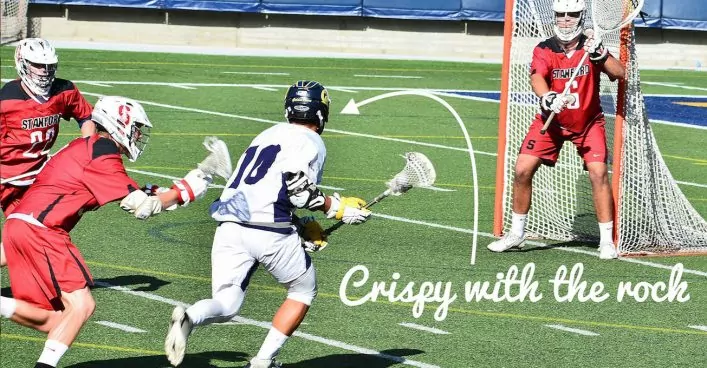 Quick Guide To Lacrosse Slang TermsApril 14, 2025
Quick Guide To Lacrosse Slang TermsApril 14, 2025 Lacrosse Goalies Rules To KnowJune 28, 2022
Lacrosse Goalies Rules To KnowJune 28, 2022 Lacrosse Goalie Step-by-Step Guide to Getting RecruitedFebruary 6, 2022
Lacrosse Goalie Step-by-Step Guide to Getting RecruitedFebruary 6, 2022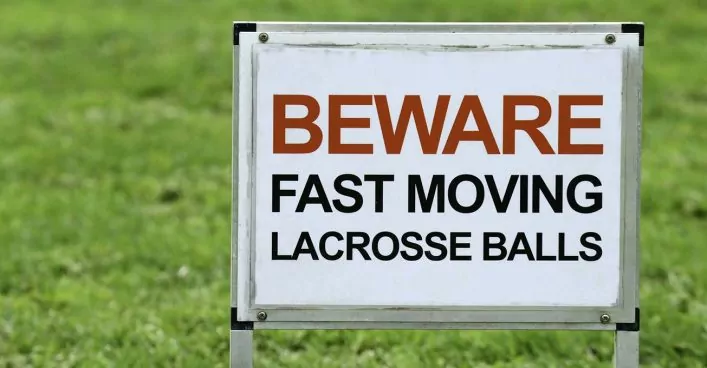 18 Lacrosse Goalie Drills to Improve Your GameApril 24, 2025
18 Lacrosse Goalie Drills to Improve Your GameApril 24, 2025 7 Elements of a Great Lacrosse Goalie StanceAug. 1, 2020
7 Elements of a Great Lacrosse Goalie StanceAug. 1, 2020 12 Lacrosse Goalie Tips To Take Your Game to the Next LevelSeptember 10, 2024
12 Lacrosse Goalie Tips To Take Your Game to the Next LevelSeptember 10, 2024 STX Eclipse 3 Goalie Head ReviewApril 24, 2025
STX Eclipse 3 Goalie Head ReviewApril 24, 2025 Lacrosse Goalie WorkoutAug. 12, 2019
Lacrosse Goalie WorkoutAug. 12, 2019 The Basics of Making a SaveJune 29, 2021
The Basics of Making a SaveJune 29, 2021









































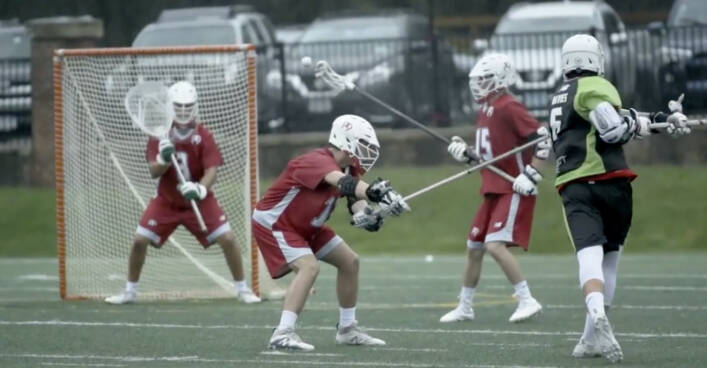
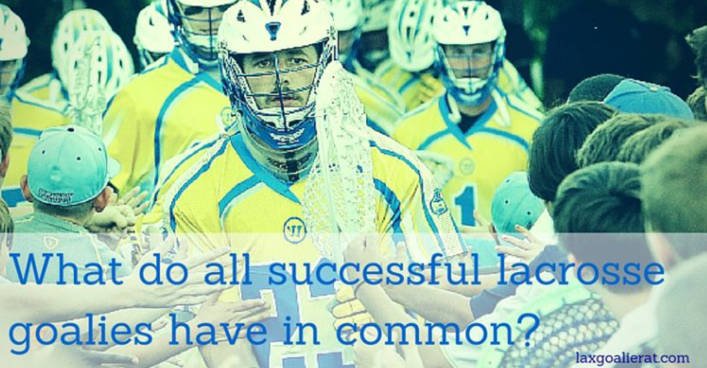

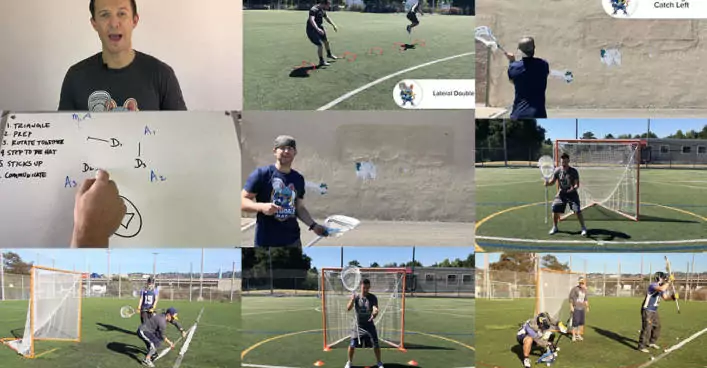









Nice job Coach. The “arc question” is one that I am asked all the time and I am glad to see that you conclude with what works best for the individual and that they should learn how to play all of the “arcs”. I would argue that the level or distance from GLE should be situational and not simply a choice of one “style” of arc over the other.
Recent history has demonstrated the efficacy of a flat arc and has made it easier for non goalie coaches to teach the position which is great. Teaching a flat crease makes the goaltender position easier to learn and teach, but in my opinion it is very one dimensional. Hockey goalies primarily play a flat crease because they can cover a large percentage of the goal without moving, but when time permits most hockey goalies will move out to shorten the angle and gain a bigger advantage over the shooter.
As shot speeds continue to increase I think we will see a trend towards a higher and more situational understanding of the arc mixed with a split leg style. With high school kids shooting in the 90’s goaltenders will be forced to adjust their angle play and rely on hand speed, body saves, and a split leg style, rather than a step to stance style.
In the end there isn’t one way to play the position and the best goalies in most sports tend towards the unorthodox and the popular “style” of play tends to follow the success of others which was clear in you presentation.
Keep up the good work.
Quint Moores
Hey Quint! Thanks for that awesome comment! I’ve also found that different arcs work better on different days. Some days when a goalie is just “on” I’ve seen the higher arc work wonders. Again, thanks for the great comment! Coach Damon
I tend to agree with the “hybrid” arc concept. For example if the shooter is farther out say just inside the restraining line, the “flat” is appropriate. If the player has just dodged and is say 10-15 yard, then the goalie would step out to cut off the angle, much like a hockey goalie, in my opinion. The issue is “if” he makes a pass to an attackman sitting on the pipe. However, “if” he continues with the shot, then statistics are greater of stopping shot. Now, back to the “if” he makes a pass scenario , has the defenseman arrived late to the slide? Is the defenseman in position to check the attackmans stick? These I believe factor into “arc’ play. You talked about “split leg”, is this where you have a “5” hole open and you use your stick to stop, or is it where you drop to your knees? If its the latter, then I tend to tell my goalies to step out and lower your hips, keeping body behind the ball and back fairly straight.
End the end it entirely up to the player and comfort level… and they have quick hands/feet and in shape. Respectfully, cololax
I think the hybrid approach makes a lot of sense. I’d rather have the goalie better setup to defend a 10-15 yard shot then to be in worse position for that shot but better able to defend an attackman on the pipe. That’s a tough save regardless. I didn’t talk about “split leg” style, that was in a comment from Quint above. I think he’s referring to butterfly style like ice hockey goalies. For low saves I actually coach my goalies to stay on their feet. Some prominent goalie coaches teach dropping to knees but I think more saves are made over time on your feet. Thanks for the comment.
My son is a young (age 11) and relatively new goalie. He plays MUCH better in a flat arc because 1) He is in better position more often (ie the sweep situation you discussed was a major problem for him before) and 2) He moves less so is able to be in his stance and ready more often. Less to think about, less moving parts. So being in better position and being in his stance seems to outweigh the benefit of cutting down more angle. At least for now…..
Hey Tim! How goes it?
It’s true even younger goalies can have a ton of success with the flat arc. Good to hear it worked for Garrett!
Great post Coach! This is a key question asked by both new goalies and veterans that are seeking instruction and feedback. As coaches our aim is to setup our goalies for their best chance of success to stop the ball. It’s important for new goalies to learn the fundamental of the position mentally, physically and intellectually and a traditional 5 step arc is a great place to start.
The goalie’s main purpose is to “Stop Ball”. To do that the goalie must #1 identify the shooter, #2 locate the ball, #3 position themselves, #4 block the ball. Once they have that down, we go into the save process. As the fundamentals are mastered, the goalie may be taught how to adapt based on their style, preferences, abilities and their opponents tendencies. Almost all of my goalies like this part.
A hybrid approach establishes the mastery of the collective skills of the position. With the goal-tenders I’ve coached over the years (boys and girls), this progression has proven successful for nearly all my players. As a former goalie, I’ve played at most levels but more importantly I’ve received alot of reverse-mentoring from my players. It helps me to gain insight, improve my coaching and assist in my players’ and the positional development.
As players and coach, we gather very frequently to evaluate and adapt our strategy for the specific competition – even at the introductory level. Whether new goalie or veteran, we get some film periodically on them, encourage them use a mirror for stance, focus on excellence and improvement on the fundamentals rather than perfection.
The position of Goalie is like a game of cat and mouse. Whether its a 5 Step or 3 Step or something else depends on the Cat 🙂
Appreciate that Michael. And thanks for adding that comment. Spot on! It all depends on the cat… hahaha
Great article, Damon. Every goalie is unique and their style should represent their best assets as a goalie and how they feel on any given day or situation. My son started off with the standard 5 pt arc , then moved to a flat arc in middle school, and is now using the hybrid as a freshman and sophomore. I have always told him to trust his hands no matter what the arc and he’s done well. By the way, your article on cups was a game changer ( and one article that I almost skipped). The hockey cup-fabulous recommendation. Thank you for your insight to the game, flexibility with adapting to new styles or techniques, and always being open to feedback from others and not pushing the this is the only way that works thought onto others. You are a great resource for coaches, goalies, and goalie parents. Take care.
Just a game changer? Hockey cups are life changers haha You’re welcome Rich! Brings me great joy to help coaches, parents, and young goalies learn this position.
Love the article on the arc. Great points on the pros and cons. However, I know we have had this discussion before, the “more time to react to a shots” is not valid. I think we as goalie coaches need to stop using it as an argument for shallower arcs or flat steps. The math, physics and physiology of the human body does not make this a true statement. The argument should be use what works best for you as goalie as stated in some of the comments and your responses.
Keep up the good work. I recommend this blog and your book to anyone wanting to get better as a goalie.
Maybe we’ll have to agree to disagree on the more time to react to shots point.
I was explaining this way to a friend the other day. Imagine if I’m throwing a grape at you and you have to catch it in your mouth.
Would you rather be 5 feet away from me or 7 feet away from me?
Closer gives you better chance of blocking the grape but further gives you more time to see it and catch it in your mouth (the virtual equivalent of making a save with our stick).
Thanks for the compliments on my site!
Excellent post Coach and I think it’s 100% spot on. My daughter plays boys, girls and box lacrosse. She constantly adjusts her arc to the shooter. 5 point if the ball is outside in boys, flat if the ball is in close, usually flat for girls and she steps all the way up to the crease for girls 8 meter free positions (you do have to make sure there is no one to feed though or they dunk it behind you).
Box lacrosse is where she really perfected her “hybrid” arc until it became muscle memory. Saves in boxla 90% positioning.
Hey Ean! Thanks for that comment! Good point on Box goalie saves its more like ice hockey goalie where positioning is 95% and reacting is 5%. Field goalies positioning also important but maybe more like a 50/50 split.
Great repost Coach,
I give this article to all my goalies when we start working together, great for Goalie IQ and understanding the physics of the position. I just want to give a quick plug for the mental game here. You mention how important it is for a goalie to pick the arc the “feels” right to them, even changing it up on any given day. I think as coaches we need to constantly be on guard not to be over directive, we need to teach all three arcs and let the goalie decide. I find that the goalie’s “feeling” or confidence, is more important than my personal belief as a coach. Confidence wins out over coaching every time when looking at performance, even if I believe they can benefit more from a different arc. I work mostly with youth through Varsity goalies and would love to hear your thoughts.
Hey Todd! I tend to agree with you – especially as they get to the HS level. I tend to start with 1 arc for the youth goalies. I want to keep things as simple as possible and let them react to the shots vs. thinking about 15 different things. Confidence definitely wins out over coaching in games. After you’ve taught them teh technique no amount of sideline coaching will get them better midgame – you just have to keep upping there confidence at that point.
When I was young I was always taught that the traditional five point arc. Not until I went to Syracuse’s camp as a freshman in high school did I learn about the functionality of the three point arc. Coach Donahue also taught me to step to the ball, and not to a shooter, which greatly improved my game. I think a goalies arc should be based off their size, and their preferred method of steps. I know goalies who still continue to step to the shooter instead of the ball when shots are fired, and it works for them. Me being a smaller goalie and more agile, I felt that moving to the ball worked better for me, which is why I adapted a hybrid arc. In college I would start coming out almost to the top of my crease when a shooter would wind up, and then settle back to the posts when it was moved to X or the angle decreased for the shooter. Another thing to consider with arc’s is your handedness. With my hybrid arc I would always leave a little more room open on my stick side because I could get my stick to the ball faster than when coming across my body. For that reason I would limit the angle of the shooter by coming out more when they were moving towards my off hand side, and then bait the shooter by leaving a little bit more net open when they moved to my stick side. It honestly took me until I started playing DII to fully understand my arc, and how I wanted to position myself. A goalie should consider their strengths and weaknesses when practicing their arc. Goalies should also base drills off their preferred method of an arc; it makes no sense for goalies to practicing stepping to the shooter with a five point arc if they prefer stepping to the ball and a three point arc more. No matter the positioning, angle drills are always important and give a goalie a better understanding of the shooters point of view.
Great article and a topic that I have stressed the importance to many youth goalies and coaches.
Thanks for adding that Casey! Great stuff in there. Arc play and positioning is so vital to the goalie game it should be one of the first things taught. I also always stepped to the shot, never the shooter.